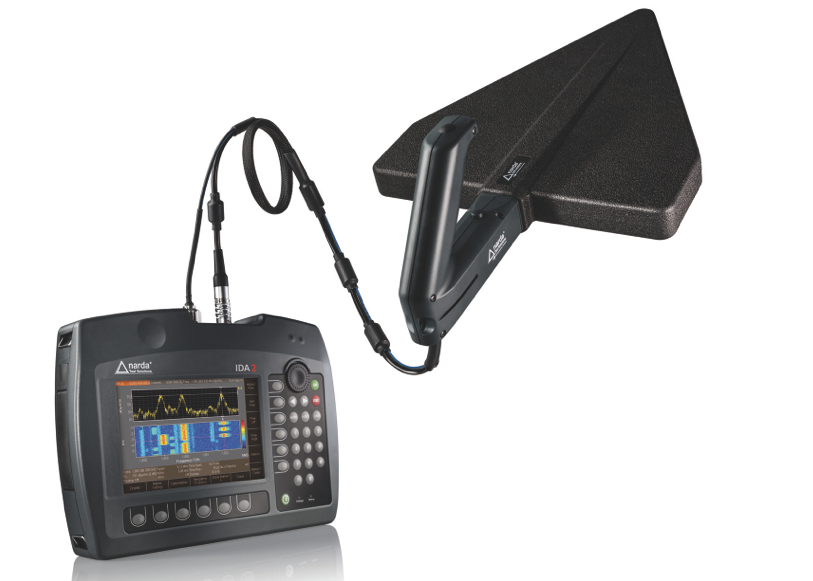[SatNews] generates high resolution spectrograms, persistence spectrums and time domain displays that were previously only available from high cost laboratory instruments.
Narda Safety Test Solutions has equipped the second generation of its Interference and Direction Analyzer with I/Q analyzer functions. Based on the I/Q data, the device generates high resolution spectrograms, persistence spectrums and time domain displays that were previously only available from high cost laboratory instruments. Radio spectrum interference and impairments can thus be detected and analyzed on the spot.

Unintentional or deliberate RF interference, illegal transmitters or interference between permitted radio signals can be difficult to detect if it only occurs sporadically or is hidden under conventional signals. Narda Safety Test Solutions has equipped the new IDA 2 with I/Q analysis functions in order to also detect and locate such signals. The instrument records the I/Q data in real time at a maximum channel bandwidth of 32 MHz, and saves up to 250,000 I/Q data pairs without compression, i.e. without loss of data.
Based on this data, the IDA 2 computes high resolution spectrograms, persistence spectrums or oscilloscope-like displays versus time. Computation is done continuously during the measurement or subsequently from the stored data set. Since the underlying data remain unchanged in thedevice memory, you can alter the display parameters such as the frequency or time resolution afterwards and zoom in on details right down to the original resolution offered by the I/Q data.
The combination of high resolution spectrograms, persistence spectrums (with afterglow effect) and time response displays enables detection,
identification and localization of signals that would otherwise remain hidden in a conventional spectrum display. Experts can therefore trace the source or cause of interference directly on site. Transferring the data set to a PC is useful for documentation or subsequent evaluation
I/Q data in the IDA 2: Technical background
IDA 2 combines analog and digital methods of signal analysis: A conventional heterodyne receiver for pre selection is followed by a digital analyzer for fine selection and further processing. The received signal is mixed down to a base band (zero span) after pre selection, frequency conversion, and A/D conversion, splitting it into its real (in phase) and imaginary (quadrature) components. The I/Q data obtained are then available for further evaluations, e.g. by FFT. The original data set is retained, so that changing the settings such as frequency resolution, time period or time resolution for the evaluation do not result in a reduction in the data.
IDA 2 fundamentals
The Interference and Direction Analyzer IDA 2 was developed for the identification and location of electromagnetic signal sources. Its applications cover both communications and security. The communications field requires that intrinsic or external interference be found and eliminated. With regard to security, the device can be used to trace unknown sources and identify any potential dangers. Here, the IDA 2 canautomatically determine the direction of the source on the basis of a horizontal scan, and display the bearing angle in a polar diagram. The IDA 2 calculates the position of the interference source and displays it automatically from several bearing results. The results can be superimposed optionally on freely available electronic maps, so that the source can be exactly localized, even down to a row of houses for example – just like a navigation system.
The position of an interference source is determined with the aid of the GPS receiver in the measuring instrument and the electronic compass in the antenna handle, which determines direction, elevation, and polarization. Various antennas optimized for different frequency ranges are available; these can be plugged on to an ergonomically shaped handle in either vertical or horizontal alignment.
Designed as a hand held unit for field use, the basic unit including battery weighs less than three kilograms. The antenna and handle together weigh less than one kilogram because the power supply is taken from the basic unit. The rechargeable battery can be hot swapped without interrupting operation. You can also find this text along with a press image under www.narda-sts.com
Narda is a leading supplier of measuring equipment in the RF safety, EMC and RF testing sectors. The RF safety product spectrum includes wideband and frequency-selective measuring devices, and monitors for wide area coverage or which can be worn on the body for personal safety. Under the PMM brand, Narda offers instruments for determining the electromagnetic compatibility (EMC) of devices. The RF testing sector covers analyzers and instruments for measuring and identifying radio sources. The range of services includes servicing, calibration, and training programs. The company operates a management system complying with ISO 9001/2008 and ISO/IEC 17025.

